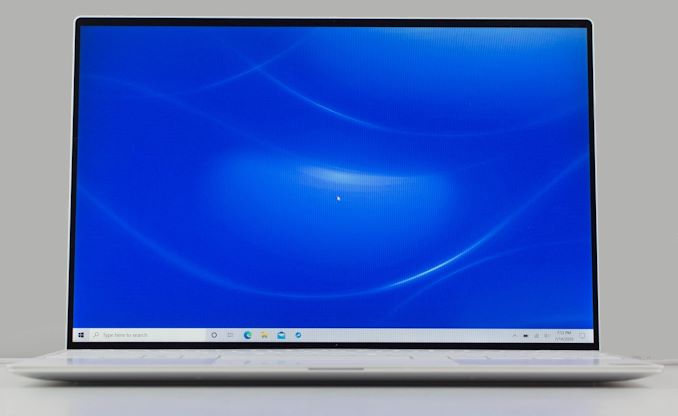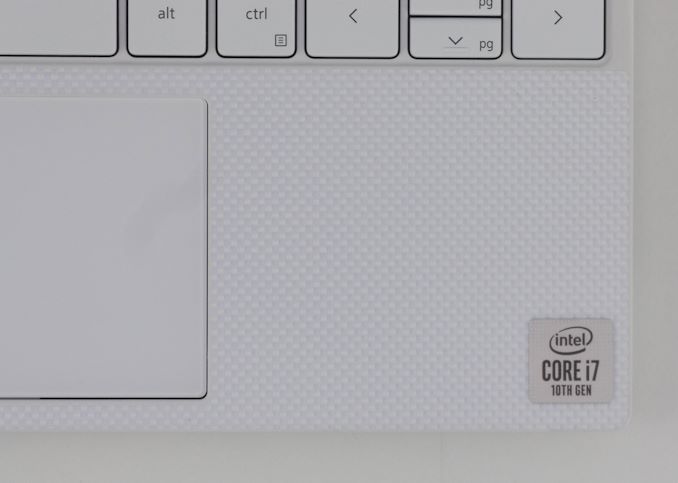The Dell XPS 13 (9300) Review: Return of the King
by Brett Howse on July 16, 2020 10:00 AM EST
Dell changed the Windows laptop market in a single stroke with the launch of the updated XPS 13 back in 2015, ushering in the world of the InfinityEdge display, and moving the entire industry forward. We were fortunate enough to get a chance to check out the precursor to the new XPS 13 back in November, with a review of the XPS 13 2-in-1. Dell had chosen not to rest on their laurels, and the 2-in-1 proved to be one of the best notebooks around if you needed a compact and powerful convertible laptop. Today we are evaluating the traditional clamshell version of the XPS 13, and while it offers many of the same features and design touches, it does so in a more familiar form factor that many customers are going to prefer.
For the 2020 refresh, Dell has made the refreshing move to taller displays, as we saw with the XPS 13 2-in-1. As a result the XPS 13 uses 13.4-inch display panel with a 16:10 aspect ratio, offering more vertical space for getting work done, and some convenient padding to place controls when watching 16:9 content. The larger display fits into a chassis that is actually 2% smaller than the outgoing design, with the new XPS 13 offering a 91.5% screen to body ratio.
This is actually the second time that Dell has refreshed the XPS 13 within the last year. The company previously updated the XPS 13 in August 2019 to use Intel's 10th generation Core processors, but presumably due to limited supply of Intel’s then-new Ice Lake platform, Dell opted to launch that iteration with Comet Lake-U processors. And under more normal circumstances we would have expected Dell to stick with an annual cadence – and thus Comet Lake – for an entire year. Instead, to some surprise, Dell gave the XPS 13 a further mid-generation refresh, launching the Ice Lake-based XPS 13 9300 model that we are reviewing today, and bringing the clamshell XPS 13 to parity with the 2-in-1 version.
The switch from Comet Lake to Ice Lake, in turn, is a significant one. it means the XPS 13 gets Intel’s new Sunny Cove CPU architecture, as well as the much-improved Gen 11 graphics. Dell offers Core i3, i5, and i7 models, with the Core i3 and i5 offering G1 graphics, meaning 32 Execution Units (EUs), and the top-tier Core i7-1065G7 featuring the full 64 EUs on the GPU side. Just as a comparison, the Comet Lake-U only offered 24 EUs of Gen 9.5 graphics, so even the base Ice Lake models still offer a 33% larger (and much newer) GPU than the outgoing models.
The move to Ice Lake also brings some badly-needed LPDDR4X support, which in turn means a 32 GB maximum memory option in the XPS 13 9300, up from 16 GB previously. Although Dell still lists a paltry 4 GB option on their specifications sheet, a quick look at the Dell.com site shows that, at least in the USA, it appears that 8 GB is the new minimum, and that is a welcome change. Offering just 4 GB of RAM in a premium Ultrabook was always a poor choice, even if it did allow Dell to hit a slightly lower price bracket. On the storage front there is more good news, with 256 GB the new minimum, with up to 2 TB available, and all drives are PCIe x4 NVMe offerings.
| Specifications of the Dell XPS 13 9300-Series | |||
| General Specifications As Tested: Core i7-1065G7 / 16GB / 512GB / 1920x1200 |
|||
| LCD | Diagonal | 13.4-inch | |
| Resolution | 1920×1200 | 3840×2400 | |
| Brightness | 500 cd/m² | 500 cd/m² | |
| Contrast Ratio | 1800:1 | 1500:1 | |
| Color Gamut | 100% sRGB | 100% sRGB 90% P3 |
|
| Features | Dolby Vision | Dolby Vision | |
| Touch Support | with or without touch | Yes | |
| Protective Glass | Corning Gorilla Glass 6 in case of touch-enabled model | ||
| CPU | Intel Core i3 1005G1 (4MB cache, up to 3.4GHz) Intel Quad Core i5 1035G1 (6MB cache, up to 3.6GHz) Intel Quad Core i7 1065G7 (8MB cache, up to 3.9GHz) |
||
| Graphics | Intel UHD Graphics Intel Iris Plus Graphics |
||
| RAM | 4 - 32 GB LPDDR4X-3733 DRAM (soldered/onboard) | ||
| Storage | 256 GB PCIe 3.0 x4 SSD 512 GB PCIe 3.0 x4 SSD 1 TB PCIe 3.0 x4 SSD 2 TB PCIe 3.0 x4 SSD |
||
| Wireless | Killer AX1650 Wi-Fi 6 + Bluetooth 5.0 (based on Intel's silicon) Killer AX500 Wi-Fi 6 + Bluetooth 5.0 (based on Qualcomm's silicon) |
||
| USB | 3.1 | 2 × TB 3/USB Gen 3.1 Gen 2 Type-C | |
| 3.0 | - | ||
| Thunderbolt | 2 × TB 3 (for data, charging, DP displays) | ||
| Cameras | Front | 720p HD webcam | |
| Other I/O | Microphone, 2 stereo speakers, audio jack | ||
| Battery | 52 Wh | 45 W AC Adapter (USB Type-C) | ||
| Dimensions | Width | 295.7 mm | 11.64 inches | |
| Depth | 198.7 mm | 7.82 inches | ||
| Thickness | 14.8 mm | 0.58 inches | ||
| Weight | non-touch 1.2 kilograms | 2.64 pounds touch-enabled 1.27 kilograms | 2.8 pounds |
||
| Launch Price | Starting at $999.99 | ||
Dell has gone all-in on USB-C with the new XPS 13, with one port on each side of the notebook. Both feature Thunderbolt 3 with 4 lanes, as well as power delivery for charging. The lack of a Type-A port may inconvenience some, but Dell does include an adapter in the box to assist. Wireless is the Killer AX1650, which based on the latest Intel AX200 wireless adapter – and with Intel purchasing Killer this partnership seems like it is not going anywhere.
If you read our review of the 2-in-1 version of this laptop, you will undoubtedly notice a lot of similarities. As they are from the same product line, that is not an accident: Dell has now refreshed their entire XPS series of laptops with a similar design philosophy. Let’s take a peek at what is new.











224 Comments
View All Comments
Jorgp2 - Thursday, July 16, 2020 - link
>Zen 2 mobile chips easily outperform Ice Lake and Comet LakeOnly in multicore, and only because they have 8 cores.
The Zen 2 architecture still has around Skylake level performance, SNC and WLC have a much higher lead over Skylake than Zen 2 does.
rhysiam - Thursday, July 16, 2020 - link
On what basis are you announcing Sunny Cove and the unreleased Willow Cove as superior architectures? Can you link to some data to support that? Because this review directly contradicts that claim.The lightly threaded tests in this very review show the 4700U trading blows with the 1065G7. Both are clocked similarly. IPC is close in workloads that are relevant to ultrabooks.
I just can't see any basis for the claims you are making here.
Deicidium369 - Friday, July 17, 2020 - link
Comparing a 2020 CPU with a 2019 CPU is not a fair comparison.sorten - Thursday, July 16, 2020 - link
Most of what I do as a software engineer, from the compilers, build tools, and the software I write, eats up the cores. So if I can get 2x the cores for less money, then that's a bonus rather than a point against AMD.vladx - Friday, July 17, 2020 - link
As a fellow software engineer, I still prefer Intel over AMD. What you win with having more cores, you lose with poor compiler optimizations and the big advantage of AVX-512 in certain workloads. Not to mention AMD platforms tend to have more bugs at launch so you spend more time finding workarounds.Spunjji - Friday, July 17, 2020 - link
@vladx with the FUD here. Nice weasel words with "tend to have more bugs" even though we're talking about a specific platform that doesn't have any egregious bugs.Santoval - Friday, July 17, 2020 - link
"and the big advantage of AVX-512 in certain workloads. "Can you name some of these workloads? Even better, out of 10 workloads (or, to make it temporal, out of every "10 programming hours") on average how many can benefit by or be accelerated with AVX-512? Hand on heart answers only please.
As for the "poor compiler optimizations" do you mean the "super aggressive compiler flags Intel tends to prefer that often result in poorer, bug prone code"?
Spunjji below covered me with the arbitrary "bugs" of the "AMD platforms".
Santoval - Friday, July 17, 2020 - link
"The Zen 2 architecture still has around Skylake level performance, SNC and WLC have a much higher lead over Skylake than Zen 2 does."That is pure, groundless BS. You have also confused the Zen 2 "architecture" (thus only the *IPC* of Zen 2) with Skylake's "performance" (both its IPC and clock speed). That is like comparing the acceleration from 0 to 60/100 of one car with the final speed of another car without even realizing the arbitrary comparison.
Finally CPUs with Willow Cove (i.e. Tiger Lake) has not even been released yet, so referring to Willow Cove in the present tense is beyond surreal.
dudedud - Friday, July 17, 2020 - link
Did you even see the Cinebench single threaded results? Zen 2 has Ice Lake performance at around the same clock (4.1 vs 3.9)Brett Howse - Friday, July 17, 2020 - link
There seems to be a lot of misinformation flying around here. Perhaps I should link to our initial Ryzen 7 4700U review in every review I do. Ice Lake is well ahead in single-threaded performance over Zen 2, despite the lower frequency. AMD has double the cores though so even lightly threaded workloads can see a nice improvement.Please reference this:
https://www.anandtech.com/show/15762/the-acer-swif...
Cinebench is just a single workload and is compute bound.
Hopefully we can update our SPEC results with a LPDDR4 laptop as well since our first take was just DDR4.